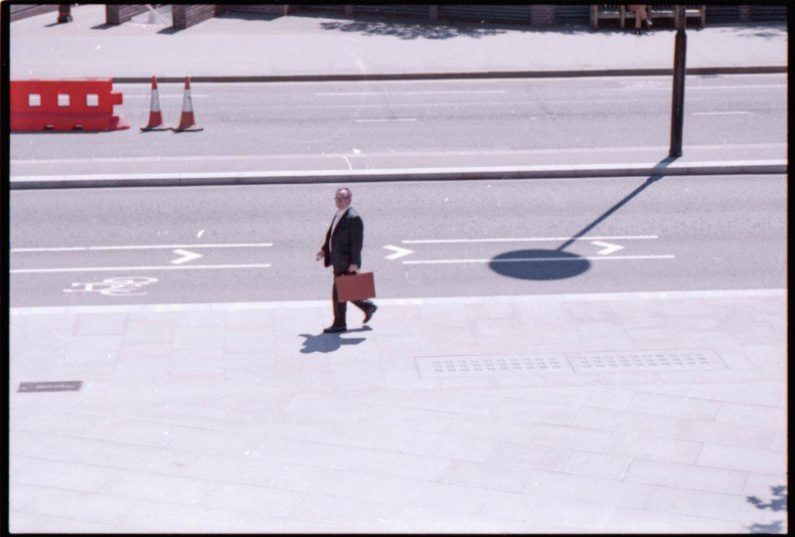
![]()
A very slight and easy change one could implement to an otherwise straightforward approach in street photography (as well as other genres) is to play with shooting from angles other than eye-level. It may an unconscious choice by some people that their perspective doesn’t shift much from their own, so I think it’s important to discuss how even a minor alteration in angle can improve, or at least change, the image.
![]()
For me, changing my angle for composition will almost always be to improve the figure-to-ground in order to isolate my subject against a clearer background. When working in a fast-paced journalistic or street photography environment, simply lowering your perspective is a great way to highlight and separate certain subjects or events.
As well as this, pulling the perspective away from eye level offers a way of looking at something that is not “basic” or generic. We are so subconsciously used to seeing things from our own perspective that very often when we see a photo that shows something even slightly different to our own experience, it can be inspirational.
![]()
When slowing down for more composition-based work, finding a vantage point can be really useful for showing this different perspective. If you want your images to be different, then finding a unique or unconventional angle can really help, whether that’s taken to an extreme or not. Some photographers will sit or lie on the floor for their lower angles, while some may seek out places where they can position themselves above others for the higher angle.
For street scenes, I find I prefer a higher angle for offering a more omniscient perspective and sense of scale over my subjects. For a scene requiring a higher angle, it is useful to have a deep literacy with your environment. I’m always exploring London for new spots that could offer me a potential image, whether that’s in museums, high-walks, or rooftops.
![]()
Once you are familiar with your terrain you can use it to shoot both down from a vantage point and also upwards using that same vantage point as a place where subjects may end up.
![]()
Lower angles can be used (especially with wide-angle lenses) to make things seem more fantastical and larger than life. I use low angles most frequently when shooting children or dogs – I always make an effort to go to their eye line as it brings the story into their world.
![]()
I find that when shooting in crowds going even slightly lower and framing against the sky is a great way to isolate my subject. Framing against the sky is one of the easiest ways to achieve good figure-to-ground, and I’m using it more and more frequently.
![]()
In this shot from an early fashion shoot, I tried to use the shape of the clouds against the blue to provide better definition as well as a slight outline for the subject.
![]()
Similarly, when possible you can frame against the ground, which can a good, clear, solid background.
![]()
If this image had been taken from eye level I think it would be weaker, as the boy would not be distinct against the wall in the background.
Using uneven grounding can be interesting as well. In this image, the road stretches away and a little upward from me, which allowed me to frame the biker against it. Composition is often about emphasis and exaggerating certain traits that may appear basic to the eye.
![]()
This is a photograph I really regret not taking from a higher angle.
![]()
If I had been even a little higher up and shot downwards then my subjects head and shoulders would not have been lost in the background in the way that you see here.
Cameras a very free to move, and with live-view and tilty-flippy screens they can be separate from your eye entirely. In your mind fix your subject as a set point in space and then explore the three dimensions with your camera – side-to-side, up and down, closer and further, until the elements simply click into place.
Drones take this to the extreme and offer one of the most unrestricted forms of photography. Although the clichés are becoming apparent it is still an emerging form, and there is still so much potential for fantastic compositions using absolutely unique birds-eye views angles. I’ve never photographed with a drone myself, but as the technology advances I will be fascinated to see what creative photographers are able to produce.
Despite all of this there will always be restrictions – sometimes you are only able to shoot an image from a specific angle, simply due to limitations of the environment.
![]()
Unless I found a ladder or a box, I would not really be able to approach this subject from another angle(in terms of height), but I still had the power to move closer and further, left and right, until I found a composition that worked for me. You can’t always have full control over the situation and your environment, so it’s really important to take the factors you do have control over and use them to the best of your ability!
About the author: Simon King is a London based photographer and photojournalist, currently working on a number of long-term documentary and street photography projects. The opinions expressed in this article are solely those of the author. You can follow his work on Instagram and you can read more of his thoughts on photography day-to-day over on his personal blog. Simon also teaches a short course in Street Photography at UAL, which can be read about here.

